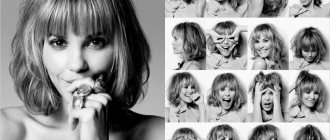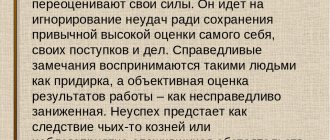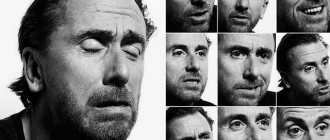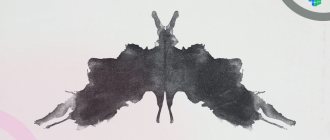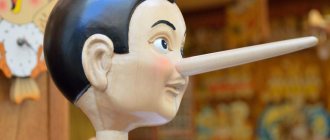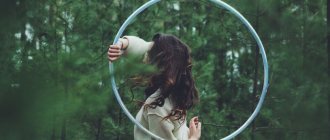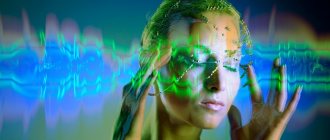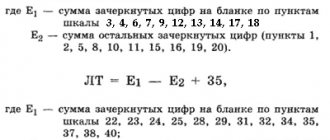Adviсe
- Secrets of facial microfacial expressions
- How to learn to read people's thoughts by their faces?
- Happiness
- Astonishment
- Anger
- Disgust
- Fear
- Sadness
- Contempt
Who hasn’t had the desire to understand what his interlocutor is thinking? Is he deceiving you? How does he really feel about your opinion? How we would like to find answers to these questions, because then we would know in advance whether we should trust this person and what to expect from him. However, everyone has such an amazing opportunity if you know the secrets of microfacial expressions. With its help you will understand how to learn to read people's thoughts in their faces!
How to build a head?
The face is one of the most difficult subjects to draw. Firstly, like any other three-dimensional object, it has many bumps and depressions. But beyond that, the face must tell a story, evoke emotion, and create the illusion that a real person is looking at the viewer from a flat two-dimensional canvas. In the modern world, we are accustomed to seeing photos of some people on every corner. Imagine a time when photography did not exist - what an incredible experience it was to see a portrait of a person drawn! The art of conveying emotions has been honed over centuries.
Let's start by building the head. There are as many different ways to construct a human head on paper as there are artists. In life, the head and face are made up of two types of tissue. Hard and immobile tissue is the bones of the skull; soft and flexible tissue is muscle and fat. Magda proposes to build a skull from three geometric shapes: an oblong sphere, a rectangular parallelepiped and a semi-cylinder.
If you want to improve your portrait skills, you'd better learn the skull shape by heart. This part of the head changes little; it is more or less the same for everyone.
If you can draw the right skull, then the face can then be stylized in any possible way, and it will always look believable.
There is only one movable element in the skull - the jaw. She has a fairly flexible joint: it allows not only to open and close her mouth, but also to move her jaw forward, backward and to the sides. Try to imitate different bites with your teeth or just grind them, and you will understand what we are talking about. This is possible due to the fact that our jaw joint has a very clever working mechanism.
When we open our mouth, the hinge that allows for rotation doesn't stay in one place—instead, the entire jaw moves forward a little! Place your finger against your cheek where you can feel the joint move. Now open and close your mouth and you will notice a slight movement of your jaw back and forth. How does this relate to drawing? It's very simple: if you draw a person with an open mouth, his chin will have to move forward a little. Otherwise, you won't be able to achieve a believable look.
Examples of nonverbal communication
Jaw
Some doubt the existence of body language, considering all conversations on this topic to be empty fiction.
People start yawning not only because they start to get bored. Lack of oxygen in a cramped office or overwork can trigger this process. Therefore, before formulating conclusions, it is necessary to understand why the interlocutor began to actively gesticulate or rotate an object in his hands.
An experiment will help reveal sign language. And the subjects can be friends and relatives, whose facial expressions, postures and gestures change in different life situations. But in no case should you impose and put pressure, otherwise you can damage many years of friendship and good relationships.
Nonverbal communication is the process of transmitting thoughts without the use of speech - the second signaling system. It absorbs 60–80% of veiled information.
And, indeed, the interlocutor is betrayed by changes in facial expressions, posture and gestures that contradict his smooth presentation. A certain inconsistency appears and serious concerns arise that he is not acting in your interests at all.
The ability to correctly read the secret language of gestures will help you avoid unpleasant situations. For example, HR specialists cannot do without knowledge about the hidden intentions of potential employees.
It is difficult for a person to hold back emotions for a long time; they must find a way out. But due to circumstances, rules of decency and norms of society, we are not free to surrender to the will of feelings and express them by changing posture, facial expressions and gestures. Often this behavior becomes the norm and turns into a habit.
If a friend is hunched over, this indicates that he has been severely offended or has experienced severe stress. The exorbitant “severity of the problems” does not allow him to straighten his shoulders. He feels discomfort because he cannot cope with the situation and thus closes down.
If the interlocutor leans towards the speaker, this means that he is interested in the topic of the conversation. So he tries to get closer to the source of information.
By tilting his head and simultaneously lowering his eyelids, the interlocutor expresses complete approval. There is no doubt about his respectful attitude. On the contrary, if a person often touches his face with his hands, touching his eyes or the corners of his mouth, he does not trust you.
An individual's condition is revealed by his hands. When excited and irritated, it is common for a person to stroke himself, straighten his hair, or roll and fiddle with the first objects he comes across in his hands. Sometimes he puts his fingers in his mouth. In this case, he needs the support and approval of his opponent.
Trust, openness, and willingness to cooperate are demonstrated by open palms. If he doesn't cross his elbows or legs, he will appeal to you. And if he puts his hands behind his back and raises his chin high, he thereby demonstrates his superiority.
To convince your partner of a serious and responsible approach to further cooperation, you should use the following method. During business negotiations, it is necessary to mentally draw a potential partner a triangle between the eyes above the bridge of the nose and look into this area.
Face sizes
The skull is very important for the basic structure of the face, but the real appearance depends on the shape of the soft tissues attached to the bone. As we already mentioned, the skull is covered with layers of muscle and fat. In some places these layers are quite thin, so we can easily see the shape of the skull underneath. Elsewhere, the muscle and fat are thick enough that they will move greatly from their normal location when facial expression changes.
In this diagram, the green color indicates the areas where the soft tissue is thinnest and you can feel the bone underneath. The shape of these areas changes minimally. As for the places that can greatly change shape, these are primarily the cheeks, lips and skin around the eyes. However, in green areas we can also observe superficial changes: skin tension changes there, and wrinkles appear or disappear.
Here's another important thing to remember: the face is not flat, it's convex. That is, when you unfold it in space at different angles, you should place it not on a flat surface, but, roughly speaking, on the side surface of the cylinder. It must be remembered that all elements of the face are ultimately placed on the head, which tends to be spherical in shape.
Psychology of Gestures
Many people can subconsciously convey their lies through body language; you will never catch a professional swindler, politician, or competent leader in a lie by watching them, because these people know them very well, work and constantly control their facial expressions and gestures. You will need this in everyday life, when communicating with colleagues at work or in other places where you spend your time.
Scratching his nose
A person who is trying to deceive you, while talking, scratches and rubs his earlobes, scratches his nose, but remember that the nose can often itch.
Unnatural smile
The interlocutor is trying to smile unnaturally, such a smile is common, the person is forcibly trying to smile.
Holds on to something, puts himself in order
When talking, a person constantly touches his hair, holds on to something standing nearby, for example, a chair, a table. For no apparent reason, a person begins to put things in order, put everything on shelves, sort it, move it to other places; behind these actions, he tries to hide a lie.
Covers mouth, avoids
The interlocutor tries to cover his mouth, or holds his hand to his throat or mouth. This gesture is a signal that the person is lying. The person’s torso goes backwards, evades suddenly, as if it swayed while riding in a vehicle. Also, if a person bites his nails or lips, think about the veracity of the stories you heard!
Shiver
The interlocutor has a strange, incomprehensible trembling, he tries to restrain it, but it still doesn’t stop. Today, very often, you can see how a person, while talking, adjusts his collar or laces. Sometimes, the hand, of course, unconsciously by the person, ends up near the groin area. The posture of the person speaking often changes; it seems that he cannot sit comfortably on a chair or sofa.
Frequent cough and wheezing
Frequent coughing of a speaking person is also a sign of untruthfulness, as if someone does not allow him to speak, interferes and dissuades him from lying. A person who smokes takes puffs very often, and it turns out that cigarettes can tell a lot about a person.
Closed poses
A person hides and hides his hands wherever possible; this is also a gesture of lying. He takes small steps or moves from one leg to the other, it seems as if he is cold and does not know how to warm up. Fencing off from you, the interlocutor crosses his arms and legs, this makes it easier for him to deceive you. Tilts his head down or back - this is a great desire to hide and close himself off from you.
Holding your breath
Men tend to hold their breath when cheating. The interlocutor may sit with his eyes half-closed or closed - he experiences a very great feeling of guilt. But don’t confuse this with a state of fatigue when a person wants to sleep and can barely look at you.
First quiet, then loud
A person who tells a lie first speaks quietly, as if he were whispering, and then, surprising everyone present, he speaks too loudly.
Beads of sweat
Beads of sweat may appear on the face of a person who is lying. Also, this gesture is used if a person is upset or angry, he tries to cool down his ardor by moving his collar.
Facial expression
When we smile, we not only lift the corners of our lips. A real smile consists of a whole set of muscle movements throughout the face. The eyebrows and wings of the nose begin to move, the shape of the eyes and mouth changes - exactly how they move depends on the expressed emotion and the individual characteristics of the person.
In this regard, it is useful to watch friends and make different faces in front of the mirror to closely study how different people show emotions. This is a good way to improve your skills - you will soon notice that your characters have become more believable.
Facial expressions: 1 - neutral, 2 - happy, 3 - sad, 4 - surprised, 5 - scared, 6 - angry, 7 - disgusted
The picture above shows basic human emotions in a simplified form. Green arrows indicate the direction of muscle movement, and blue lines mark the wrinkles that form. If you want your characters to look young, don't give them expression lines like black lines. Because the more of these wrinkles you draw, the older/uglier the character will look. Instead, it is better to pay attention to the nuances in changing the shape of the eyes, eyebrows and mouth - they are able to make a huge variety of movements.
No. 6 Why cosmetology doesn’t work
To restore a vibrant face and improve microfacial expressions, you will be offered dozens of procedures: collagen therapy, biorevitalization, lifting, peeling and lasers... You can remember all these names - but only to never put them into practice. However, not a single cosmetic procedure will help you get out of the web of fibrosis. To verify this, it is enough to understand the basic principles of the face:
The aging process is associated not so much with cells, but with the space between them - the intercellular or extracellular matrix, fascial or fiber network. The main “players” of the extracellular matrix are collagen, elastin and hyaluronic acid. Collagen and elastin produce special cells - fibroblasts, which can function only on intact collagen filaments. Hyaluronic acid molecules retain water, nutrients and trace elements.
With age, protein cross-links of collagen and elastin accumulate in the extracellular matrix. These dead threads create a real web, turning the intercellular space into a tight, lifeless mass. And additional portions of collagen from tablets and injections only increase this ballast. The “supplement” of hyaluronic acid does not help the face either. There is a strictly defined amount of it in the body, and it doesn’t need more. The problem is the quality of the hyaluronic acid, which does not receive enough water.
Eye and eyebrow movements
As folk wisdom says, eyes are the mirror of the soul. This is truly an extremely expressive facial feature. The eyes alone are enough to show emotions such as fun, fear or anger. The eye is surrounded by numerous muscle groups. With their help, a person can, for example, open his eyelids wide, showing the entire iris. Another muscle contraction will cause the eye, on the contrary, to squint, and wrinkles will appear around it.
The eyebrows have separate, their own muscle groups. The outer and inner tips of the eyebrows are controlled by different muscles, so the eyebrows can not only rise and fall, but also take on a wave-like shape! There are also special muscles with which we bring our eyebrows together above the bridge of our nose.
The picture above shows examples of eyes (J1, J2 and J3) expressing the same emotion - joy.
The eyebrow is in a neutral position or slightly raised. It is also important that when we smile, the outer corners of the eyes squint and rise upward due to the displacement of the cheeks. By the presence of this squint, a sincere smile can be distinguished from a fake one.
Pictures A1, A2 and A3 show eyes expressing anger or disgust. The muscles above the bridge of the nose do the hard work here. They bring the eyebrows together and pull them down, thereby creating many wrinkles between the eyebrows and on the bridge of the nose. The eyes in F1, F2 and F3 express shock and fear. This is the only facial expression in which the eyelids reveal the entire iris. Depending on the shape of the eyebrows, wide open eyes can express different emotions - from surprise to horror.
Examples of signs
Why does a person gesture when talking? To understand people and establish interpersonal relationships, it is important to know what gestures mean. If an individual gesticulates vigorously during a conversation, this means his emotional state
He is trying to enhance the meaning of his speech, to convey information to people's consciousness. Gestures are usually used when words alone are not enough.
Hands open for a hug signal a joyful mood. Aggression is expressed through sudden short movements.
Basic speaking gestures used when communicating:
- Scratching. If a person rubs his earlobe, he wants to speak. Rubbing your neck or cheek indicates uncertainty or mistrust of your partner.
- Crossing limbs. Crossed arms or legs symbolize energetic closedness. The person either does not want to come into contact with the opponent or is telling a lie. People often cross their arms over their chest in an unfamiliar environment where they feel insecure. Also, hands on the chest speak of distrust and a negative attitude towards the opponent. If at the same time the fists are clenched, then the person is in extreme tension.
- Fingers clasped. If a person clasps his fingers and holds them out in front of him, he is unfriendly. The closer they are to the face, the stronger the negative. Although at the same time the individual can openly smile and agree with the interlocutor.
- Hands behind your back. Hands clasped behind your back indicate a sense of personal superiority. He is open to his opponent because he does not feel threatened. If at the same time a person scratches the back of his head or rubs his face, this, on the contrary, is evidence of awkwardness. This is his way of trying to hide his insecurities.
- Hands in pockets. Such a gesture is evidence of secrecy, an attempt to hide important information. Shy people also keep their hands in their pockets because they don’t know where to put them. Such individuals have slumped shoulders and an uncertain gaze. Clenched teeth and narrowed eyes while simultaneously placing your hands in your pockets indicate anger and rage.
- Open hands. Open hands, palms up, are held by people who have nothing to hide. They seem to demonstrate the sincerity of their thoughts, the absence of “a stone in their bosom.” This technique is often used by businessmen when negotiating and signing a contract.
Hands to chest. A person presses his hands to his chest when he declares his love or asks for something. Fraudsters do this when they want to achieve a goal. In fact, their intentions are far from good.
Hands behind your head. This gesture is typical of self-confident people who feel superior. The simultaneous crossing of legs indicates an argumentative person. This position irritates many; this is usually how a boss sits in front of his subordinates. However, this body position is adopted by a person who is tired from work and trying to relax. This means that he feels comfortable and does not expect a trick.
Biting objects. Many people have the habit of chewing on a pen or pencil during a dialogue. This may indicate disbelief in what has been heard or that the individual is thinking about the issue. When a person chews his fingers, he needs approval or praise.
Sign language is very versatile and interesting. It helps to better understand your opponent, build trust, or prevent danger.
After analyzing the movements and facial expressions of an individual, you can easily calculate his next actions. Non-verbal communication is often used by scammers and swindlers.
However, everyone can apply the acquired knowledge in everyday life. You should also reconsider your own habits. Perhaps the manner of keeping your hands in your pockets does not mean anything, but the interlocutor can interpret it incorrectly.
How to learn to read people? Find out from the video:
Our interesting VKontakte group:
Mouth movements
The lips are also surrounded by many muscle groups, giving them the ability to take on an infinite number of shapes. This allows us not only to express emotions, but also to pronounce various sounds. Have you ever wondered why we draw little vertical lines on the sides of our mouths? The corner of the mouth includes a ganglion (N) to which many muscles are attached (Figure S1). This knot has a spherical shape, which creates a small curved shadow in the corner of the mouth.
The pictures above and below show some of the lip shapes used to express joy, fear and anger. When drawing the mouth, do not forget that when the teeth open, the chin should be lowered. The upper lip tends to tighten and expose the teeth. If this occurs when smiling, the lip curl will be slight (Figures S2 and S3). But to convey anger or disgust, the lip will curve more aggressively, as shown below (G1, G2 and G3).
The muscles of the mouth can work asymmetrically, for example, we can smile with one corner of our lips. To understand what possibilities this opens up, experiment in front of a mirror.
Nose movements
When it comes to expressing emotions, the role of the nose is underestimated. However, he is able to bring subtle but important nuances to a facial expression - if you draw it correctly, of course. Notice that in Figure N4 the nostrils extend along with the mouth. And when a person inhales deeply, they open wider than usual. This will help draw a tense facial expression, like in Figure N5. When we are angry or disgusted, we wrinkle our nose (N2 and N3).
Facial expressions with the corresponding nose: N1 - neutral, N2 - disgust, N3 - angry disgust, N4 - surprised, N5 - tense
We advise you to experiment more, mix different emotions and create unique expressions on the characters' faces. The main thing is to observe nature as much as possible! The Mirror is an essential tool for any character designer.
By improving our character we improve our appearance.
Our behavior and emotions are connected with our appearance, our face. The most common emotions shape character and shape our face. Therefore, there is a direct connection between our character and our faces. So be kind! Avoid irritability. By improving our character, we improve our appearance.
I led the practical psychology club for eight years. We conducted many different classes and trainings, completely different. But there were also activities aimed at inner and outer beauty, at harmony. And I saw how people “bloomed” and their faces changed.
There is a wonderful poem on our topic of human faces.
About the beauty of human faces. The poet, Nikolai Zabolotsky , perfectly revealed the theme of the beauty of human faces. Comparing faces with house facades is a wonderful metaphor, you’ll agree...
About the beauty of human faces
Nikolay Zabolotsky
There are faces like lush portals, Where everywhere the great appears in the small. There are faces - like miserable shacks, where the liver is boiled and the rennet gets wet.
Other cold, dead faces are closed with bars, like a dungeon. Others are like towers in which no one has lived or looked out of the window for a long time.
But I once knew a small hut, It was unprepossessing, not rich, But from its window the breath of a spring day flowed onto me.
Truly the world is both great and wonderful! There are faces - similarities to jubilant songs. From these notes, shining like the sun, a song of heavenly heights is composed.
There is one more poem. Vladimir Vysotsky. Still the same topic, but presented differently. If you are not interested, you can scroll through and read the article further.
We draw an illustration where the main thing is the expression of emotions
Understanding the basics opens up unlimited possibilities for character stylization. Let's go back to the beginning of the article, where we looked at the basic geometric construction. The three main figures remain unchanged, but their proportions can and should be changed! This allows you to create stylized yet believable faces.
Working with simple geometric shapes also helps control the tilt of the head in perspective. For example, we want to draw a cute character with big eyes and a round face, who tilts his head back slightly. To do this, you need to increase the size of the parallelepiped, make the half-cylinder shorter, and take into account the perspective when constructing these figures. At the next stage, we draw a skull corresponding to these proportions, and on top of it - the face itself.
To make the smile look sincere, let's raise our eyebrows and slightly cover the lower eyelid with our cheek. Notice how the stretched mouth lifts the cheek and makes it more rounded.
About the author:
Magdalena Proszowska, or simply Magda Proski, is a German artist of Polish origin. Known primarily for her stylized, eye-catching portraits and illustrations. She works as a senior concept artist at the German studio Ubisoft, which is developing the building strategy The Settlers. It is noteworthy that as a digital artist, Magda is self-taught. That does not prevent her from being a guest teacher at universities of game art in Cologne and Düsseldorf.
Original article in English
